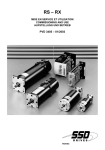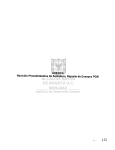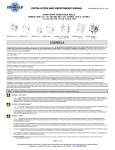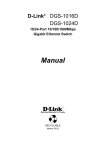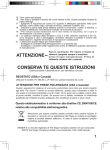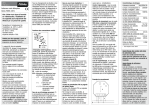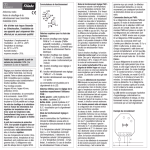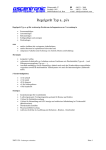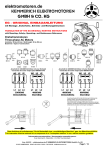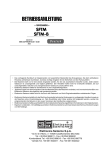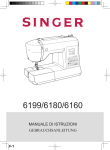Download PVD3322 : Manuel de mise en service pour supporter la
Transcript
TBN 103 – 206 - 306 Dynamos tachymétriques / Tacho generators / Tachogeneratoren MISE EN SERVICE ET UTILISATION COMMISSIONING AND USE AUFSTELLUNG UND BETRIEB PVD 3322 – 01/2003 TBN 103 – 206 - 306 TABLE DES MATIERES / CONTENTS / INHALTSVERZEICHNIS 1. 1.1 1.2 1.3 1.4 2. 2.1 2.2 2.3 2.4 3. 3.1 3.2 3.3 3.4 MISE EN SERVICE ET UTILISATION 2 GENERALITES PRESCRIPTIONS DE MONTAGE ET D'UTILISATION MONTAGE POUR TBN 206 ET 306 BALAIS 2 2 3 3 COMMISSIONING AND USE 5 GENERAL INSTRUCTIONS FOR INSTALLATION AND USE ASSEMBLY for TBN 200 and 300 BRUSHES 5 5 6 6 AUFSTELLUNG UND BETRIEB 8 ALLGEMEINES MONTAGE MONTAGE für TBN 200 und 300 BÜRSTEN 8 8 9 9 Date de la mise en service / Start up date / Erstinbetriebnahme / Fecha de puesta en servicio : Date de livraison / Delivery date / Lieferdatum / Fecha de entrega : Type de servomoteur / Servomotor type / Servomotortyp / Tipo de servomotor : 1 PVD 3322 01/2003 TBN 103 – 206 - 306 1. MISE EN SERVICE ET UTILISATION 1.1 GENERALITES T B N 2 06 Les génératrices tachymétriques en kit TBN sont destinées à fournir l'information de vitesse, sans retard et sans énergie électrique auxiliaire. Montées sans accouplement, donc très rigides, les génératrices tachymétriques TBN usinées au micron donnent une image fidèle de la vitesse instantanée, du passage à vitesse nulle et du sens de rotation. TACHY Bobinée Nouvelle Taille 2 6V/ 1 000 tr/min La présente notice décrit les modèles TBN 100 - 200 - 300. La génératrice tachymétrique TBN 400 fait l'objet d'une notice séparée. Les modèles TBN sont prévues entre autres, en association avec les servomoteurs suivants: Type standard TBN 103 diamètre mm Ø 39 RS RS1 RX - TBN 206 Ø 49 RS2…..RS4 RXI - RX3 TBN 306 Ø 64 RS5+ RS6 RX5 + RX6 AXEM F9-Fl2 MD11-MD13 - 1.2 PRESCRIPTIONS DE MONTAGE ET D'UTILISATION 1.2.1 Réception du matériel Toutes les tachys font l'objet d'un contrôle rigoureux avant l'envoi. • Ne pas les manipuler par les câbles; • Vérifier également que les valeurs de la plaque signalétique sont en conformité avec les valeurs de votre commande. En cas de détérioration du matériel dû au transport, le destinataire doit immédiatement faire des réserves auprès du transporteur par lettre recommandée, sous 24 h. 1.2.2 Stockage En attendant le montage, le matériel doit être entreposé dans un endroit sec, sans variation brutale de température pour éviter la condensation. Si le matériel doit être entreposé longtemps, vérifier si le bout d'arbre et la face de la bride sont toujours bien enduits d'un produit anticorrosion. 2 PVD 3322 01/2003 TBN 103 – 206 - 306 1.2.3 Livraison Les tachys TBN 103 sont en principe livrées montées sur les servomoteurs. Les génératrices tachymétriques TBN 206 et 306 sont livrées assemblées (rotor - stator), avec bague de serrage sur le rotor. Les vis de fixation avec rondelles sont jointes séparément dans un sachet. Si par inadvertance, le rotor est déboîté du stator, retirer les balais (délicatement) comme indiqué au chapitre 1.4. Réemboiter le rotor dans le stator et suivre les instructions de montage. Ensuite replacer les balais. 1.3 MONTAGE POUR TBN 206 ET 306 Pour le montage des TBN 103, nous consulter Les génératrices tachymétriques PARVEX sont des instruments de mesure à manipuler avec précaution, dans de bonnes conditions de propreté. Eviter absolument la présence d'huile ou de copeaux. Ne pas prendre le rotor par le collecteur. Les traces de doigts que l'on peut éliminer par nettoyage à l'alcool, amèneraient des anomalies dans le fonctionnement de la génératrice. Voir pages 11 - 12 pour les dimensions d'arbre et de bride et la qualité géométrique demandée. La cote 2±0.2 entre la face d'appui de la tachy et le collet de l'arbre, peut être obtenue à l'aide de rondelle de calage. L'interface étant respectée, présenter la génératrice sur le bout d'arbre et faire glisser l'ensemble rotor et stator jusqu'à la face d'appui. Fixer le stator avec les 2 vis et rondelles. Couple de serrage pour TBN 200 6 + cm.daN, pour TBN 300 14 + cm.daN. 2 0 4 0 Vérifier que le rotor est en appui sur le collet de l'arbre, puis serrer progressivement les 3 vis de la bague de serrage. Couple de serrage : 14 + cm.daN. 4 0 1.4 BALAIS La durée de vie des balais est très longue, une vérification toutes les 5000 h est souhaitable. Eviter de démonter les balais sans nécessité 1.4.1 Démontage et montage du bouchon Bouchon plug Kappe Démontage : Utiliser un tournevis pour faire levier sur la base du bouchon ; celui-ci est simplement emmanché sur un cône inversé. Montage : Placer le bouchon sur la pièce terminale puis pousser dessus pour le descendre en place. S'assurer que la lèvre inférieure du bouchon soit bien en contact avec la collerette du porte-balai S'assurer de la présence du joint pour les tachys TBN 206. 3 PVD 3322 01/2003 TBN 103 – 206 - 306 1.4.2 Vérification de l'usure des balais il est possible de vérifier l'usure des balais sans les démonter : Introduire une tige métallique (trombone dépliée) de Ø 0,8 maxi par le trou de la pièce terminale. Agir avec précaution, le shunt du balai et le ressort sont fragiles. Mesurer la cote X puis comparer avec les valeurs suivantes: Balai neuf X = 7,5 mm Balai usé X = 13 mm 1.4.3 Démontage et montage des balais Démontage Utiliser une tige métallique Ø 1 maxi pliée en forme de U (par exemple un morceau de trombone). Placer cette tige sous la pièce terminale et faire levier vers le haut. Montage Introduire une tige métallique (trombone) de Ø 8 maxi par l'orifice de la pièce terminale, dans le ressort pour le redresser. Monter le balai dans la chemise du porte-balai. Descendre la pièce terminale puis l'emmancher par pression sur le cône inversé de la chemise. Agir avec précaution. le shunt du balai et le ressort étant fragiles. Remettre le bouchon caoutchouc par pression. Balais de rechange . TBN 100 TBN 200 300 Nbre de balais 2 4 4 Référence du balai Référence du bouchon 283672R0001 282779P0001 4 PVD 3322 01/2003 TBN 103 – 206 - 306 2. COMMISSIONING AND USE 2.1 GENERAL The TBN precision tacho generators are designed for high precision speed monitoring. They supply a voltage proportional to the speed, without delay and without additional energy. This brochure describes the TBN 100 - 200 - 300 type. The TBN 400 tacho is described in a separate brochure. The TBN tachos are fitted in association with the following servomotors : Standard typ TBN 103 diameter mrn Ø 39 RS RS1 RX - TBN 206 Ø 49 RS2…..RS4 RXI - RX3 TBN 306 Ø 64 RS5+ RS6 RX5 + RX6 AXEM F9-Fl2 MD11-MD13 - 2.2 INSTRUCTIONS FOR INSTALLATION AND USE 2.2.1 Equipment delivery All tachos undergo a thorough quality control procedure before dispatch: • Do not hold tachos by the cables • Check that the information on the identification plate corresponds to your order. if the equipment has been damaged in transit, the recipient should immediately complain to the carrier by registered letter within 24 hours. 2.2.2 Storage Before installation, the material should be stored in a dry place without large temperature variations in order to prevent condensation. if it is to be stored for a long time, check that the end of the shaft and the face of the flange are always coated with an anti-corrosion product. 5 PVD 3322 01/2003 TBN 103 – 206 - 306 2.2.3 Delivery TBN 103 are normally already mounted on the servomotors. The TBN tachometers are supplied assembled (rotor and stator) with lock ring on the rotor. Stator fastening screws and washers are enclosed in a bag. If, by inadvertence, when assembling, the rotor is disconnected from the stator, remove the brushes as indicated in § 2.4, reassemble rotor and stator and follow the assembly instructions. Then replace the brushes. 2.3 ASSEMBLY for TBN 200 and 300 (For TBN 1 00 assembly, consult us) The TBN tacho-generators are metering instruments and must be handled with care and in very clean conditions. Avoid absolutely the presence of oil or dust. Do not handle the rotor via the commutator. Fingermarks, that can be removed by cleaning with alcohol, would produce anomalies in the operation of the generator. See page 11 - 12 for the shaft and flange dimensions and the geometrical quality required. Size 2±0.2 between the bearing face of the tachometer and the shaft shoulder can be obtained using adjusting washers. After checking the geometry, place the generator on the shaft end and slip the rotor/stator assembly up to the bearing face. Fasten the stator with the two screws and washers. Torque : 6 + cm.daN for TBN 200 and 14 + cm.daN for TBN 300. 4 0 2 0 Check the correct location of the rotor on the shaft shoulder, then gradually tighten up the three screws of the clamping ring. Torque : 14 + cm daN. 4 0 2.4 BRUSHES The technological improvements give more than 1 0000 operating hours between maintenance. Brush wisar control could be made every 5000 h. Do not disassembly if not necessary. 2.4.1 Disassembly and monting the cap Bouchon plug Kappe Disassembly : Use a screwdriver as lever on the base of the cap. Mounting : Push the cap on the top to lower it in place. Make sure that the lower lip is in contact with the brush holder flange. 6 PVD 3322 01/2003 TBN 103 – 206 - 306 2.4.2 Checkinq the wear on the brushes For ex : every 5 000 h. Take the cap off. Checking without disassembling the brush : insert a Ø 0,8 dia. max metal rod through the opening in the terminal section. Operate carefully because shunt ant spring are fragile. Measure the size X then compare with the following values : New brush X = 7.5 mm Worn brush X = 13 mm 2.4.3 Brushes disassembly and mounting Disassembly: Use a Ø 1 max metal rod bent to U form (for example a bit of paperclip). Place this rod under the terminal section and lever upwards. Mounting : insert a Ø 8 max metal rod (paperclip) through the opening in the terminal part, in the spring to straighten it. install the brush in the brush-holder sleeve. Lower the terminal section then press it onto matched tapered surface of the sleeve. Operate carefully, shunt ont spring are fragile. Put the cap as 4.1. SPARE - PARTS TBN 100 TBN 200 300 Brush QY 2 4 4 Code for 1 brush Code for 1 cap 283672R0001 282779P0001 7 PVD 3322 01/2003 TBN 103 – 206 - 306 3. AUFSTELLUNG UND BETRIEB 3.1 ALLGEMEINES Die permanenterregte Tachodynamos von Typ TBN sind als Meßwertaufnehmer eingesetzt. Durch die direkte Montage der Hohlwellen-Präzisionstachogeneratoren auf die Motorwelle wird eine sehr hohe Steifigkeit erreicht; diese führt zu einer exakten Geschwindigkeitswiedergabe sowohl bei hohen Drehzahlen als auch bei Schleichdrehzahlen Diese Anweisung beschreibt die TBN 100 - 200 - 300 Typen. Die TBN 400 ist in ein separate Anweisung beschreibt. TBN Typen sind in zusamenhang mit die folgenden Servomotoren vorgesehen. Standard Typen TBN 103 Durchmesser mm Ø 39 RS RS1 RX - TBN 206 Ø 49 RS2…..RS4 RXI - RX3 TBN 306 Ø 64 RS5+ RS6 RX5 + RX6 AXEM F9-Fl2 MD11-MD13 - 3.2 MONTAGE 3.2.1 Empfang des Materials Alle Tachos werden vor dem Versand sorgfaltig überprüft. • Die Tachos dürfen nicht mit Hilfe der Kabel bewegt werden; • Vergewissern Sie sich, daß die Leistungsschilddaten mit den in Ihrer Bestellung gemachten Angaben übereinstimmen. Falls das Material während des Transports beschädigt worden sein sollte, muß dies dem Zulieferer innerhalb von 24 Stunden per Einschreiben mitgeteilt werden. 3.2.2 Lagerung Wenn der Tacho nicht sofort aufgestellt wird, muß er an einem trockenen Ort mit gleichbleibender Temperatur gelagert werden, um das Auftreten von Kondenswasser zu vermeiden. Bei langfristiger Lagerung ist darauf zu achten, daß das wellenende und die Flanschoberfläche stets vollständig mit einem Rostschutzmittel bedeckt sind. 8 PVD 3322 01/2003 TBN 103 – 206 - 306 3.2.3 Lieferung Die Tachometer TBN werden montiert geliefert (Rotor und Stator), mit Klemmring auf dem Rotor. Die Befestigungsschrauben mit Scheiben sind in einem Säckchen beigefügt. Falls aus Versehen der Rotor aus dem Stator heraugezogen wird, sind die Bürsten wie in § 3-4 angegeben (vorsichtig) herauszunehmen. Der Rotor wird germäss Montagevorschrift in den Stator montiert. Danach Bürsten montieren. 3.3 MONTAGE für TBN 200 und 300 Für TBN 100 Einbau, bitte Werk anfragen. Die Tacho generatoren TBN sind Messinstrumente, die unter guten Sauberkeitsbedingungen mit Vorsicht zu handhaben sind. Die Nähe von Öl und Spänen ist unbedingt zu vermeiden. Der Rotor nicht durch den Kollektor handhaben. Fingerspuren, die man durch Reinigung mit Alkohol entfernen kann, würden Störungen im Betrieb des Generators verursachen. Siehe Abb. 2 für die Wellen-und Flanschabmessungen und die gewünschten geometrischen Toleranzen. Das Mass 2±0.2 zwischen Auflagefläche des Tachogenerators und Wellenbund kann mit Hilfe von Ausgleichscheiben erhalten werden. Unter Beachtung der Anbaufläche den Generator am Wellenstumpf anordnen und die Rotor-StatorEinheit bis zur Auflagefläche gleiten lassen. Stator mit den beiden Schrauben und Unterlegscheiben befestigen. Drehmoment = 6 + cm.daN für TBN 200 und 14 + cm.daN für TBN 300. 4 0 2 0 Prüfen, ob der Rotor auf dem Wellenbund aufliegt, dann die drei Schrauben des Spannring langsam anziehen. Drehmoment = 14 + cm.daN 4 0 3.4 BÜRSTEN Die Bürsten sind wartungsfrei wahrend der Kugellagerlebensdauer des Antriebs. Vermeiden Sie unnötige Demontage. 3.4.1 Demontage und montage der Kappe Bouchon plug Kappe Demontage : Ein Schraubenzieher verwenden, um eine Hebelwirkung an der Verschlussbasis zu erhalten; der Kappe ist einfach auf einen umgekehrten Kegel eingerastet. Montage: Kappe das Abschlussteil aufbringen, drücken bis zum einrasten. Sich vergewissern, dass die untere Lippe des Kappe mit dem Bürstenhalterbund in Berührung liegt. 9 PVD 3322 01/2003 TBN 103 – 206 - 306 3.4.2 Uberprüfung vom Bürstenverschleiß Z.B. alle 5 000 Betrieb stunden. Überprüfung ohne Ausbau der Bürste, mit z.B. eine Büroklammer. Ein Metallstift Ø 0,8 max. durch die Öffnung des Abschlussteils einführen Vorsichtig vorgehen, da die Litze der Bürste und die Feder empfindlich sind. Absand X messen, dann mit folgenden Werten vergleichen : Neue Bürste X = 7,5 mm Abgenutzte Bürste X = 1 3 mm 3.4.3 Demontage und montage der Bürste Demontage: Ein in U-formigen gebogenen Metallstift Ø 1 max. verwenden (z.B. Teil einer Büroklammer). Diesen Stift unter dem Abschlussteil anordnen und eine Hebelbewegung noch oben machen. Montage : Eine Metallstift Ø 8 max. durch die Öffnung des Abschlussteils in die Feder einführen, um diese aufzurichten. Bürste in den Köcher des Bürstenhalters montieren. Abschlussteil senken und drücken bis zum einrasten auf dem Köcher. Vorsichtig vorgehen, da die Litze der Bürste und die Feder empfindlich sind. Kappe wieder einrasten. ERSATZTEILE Bürste mit Feder, Litze und Abschlussteil TBN 100 TBN 200 300 Bürsten Anzohl 2 4 4 Referenz für 1 Bürste Referenz für 1 Kappe 283672R0001 282779P0001 10 PVD 3322 01/2003 TBN 103 – 206 - 306 TBN 103 Interface pour montage Interface for mounting Schnittstelle für Montage TBN 206 Encombrement Dimensions Abmeβungen 11 PVD 3322 01/2003 TBN 103 – 206 - 306 TBN 306 SPECIFICATIONS / KENNDATEN Fem à 1 000 tr/min. à vide EMF / 1000 rpm (open circuit) / EMK / 1000 min-1 Ecart de bidirectionnalité de FEM Bidirectional tolerance / Abweichung Rechts-Linkslauf Ondulation résiduelle crête à crête. (Filtre / Filter. RC Filter 800 Hz) Peak-to-Peak ripple / Restwelligkeit (Spitze-Spitze) Linéarité rapportée à 3 600 tr/min. Linearity with reference to 3 600 rpm Linearität (bezogen auf 3 600 min-1) Courant Max thermique Maximum permissible current / Max. zul. Strom Vitesse maxi mécanique Maximum speed / Maximal Drehzahl Moment d'inertie / Rotor moment of inertia / Laüfertragheitsmoment Dérive de la FEM avec la température Temperature coefficient / Abweichung der EMK/°C Résistance d'induit à 25°C Rotor teminal resistance at 25°C / Ankewiderstand Self inductance / inductance / Induktivität Classe d'isolation / Insulation class / Isolierklass Classe de protection / Degree of protection / Schutzart Masse / Net weigt / Gewicht 12 PVD 3322 01/2003 TBN 103 TBN 206 TBN306 V 3 6 6 %Ke <1 <1 <1 %U ≤5 ≤3 ≤2 % ≤ 0.2 ≤ 0.15 ≤ 0.15 mA 15 15 25 10 000 10 000 6 000 0.15 0.5 2.5 %/°C - 0.015 - 0.015 - 0.015 Ω 60 47 11 mH 14 IP 40 B 120 11 IP 40 B 120 6 IP 40 B 250 tr/min. rpm/Upm Kgm2 10-5 g SSD Parvex SAS 8, avenue du Lac – BP249 F-21007 Dijon Cedex Tel : +33 (0)3 80 42 41 40 Fax : +33 (0)3 80 42 41 23 www.SSDdrives.com PARVEX PRODUCT RANGE 1 - « BRUSHLESS » SERVODRIVES • BRUSHLESS SERVOMOTORS - Very high torque/inertia ratio (high dynamic performance machinery): NX -HX - HXA NX - LX - High rotor inertia for better inertia load matching: HS – LS - Varied geometrical choice : short motors range HS - LS or small diameter motors : HD, LD - Voltages to suit different mains supplies : 230V three-phases for «L – NX series» 400V, 460V three-phases for «H – NX series» • • 1 to 320 0,45 to 64 N.m N.m 3,3 to 31 N.m 3,3 to 31 9 to 100 N.m N.m "DIGIVEX DRIVE" DIGITAL SERVOAMPLIFIERS Single -Axis : DSD Compact Single-Axis : DµD, DLD P owe r Single -Axis : DP D Multiple-Axis : DMD "PARVEX MOTION EXPLORER" ADJUSTING SOFTWARE 2 - SPINDLE DRIVES • • SPINDLE SYNCHRONOUS MOTORS "HV" Compact Series "HW" Electrospindle,frameless, water-cooled motor "DIGIVEX" DIGITAL SERVOAMPLIFIERS From 5 to 110 kW up to 60,000 rpm 3 - DC SERVODRIVES • • • "AXEM", "RS" SERIES SERVOMOTORS "RTS" SERVOAMPLIFIERS "RTE" SERVOAMPLIFIERS for DC motors + resolver giving position measurement 0.08 to 13 N.m 4 - SPECIAL ADAPTATION SERVODRIVES • • "EX" SERVOMOTORS for explosive atmosphere "AXL" COMPACT SERIES SERVOREDUCERS 5 - POSITIONING SYSTEMS • • • • Numerical Controls « CYBER 4000 » 1 to 4 axes "CYBER 2000" NC 1 to 2 axes VARIABLE SPEED DRIVE - POSITIONER Single -Axis : DSM P owe r Single -Axis : DP M Multiple-Axis : DMM ADJUSTMENT AND PROGRAMMING SOFTWARE PARVEX MOTION EXPLORER 5 to 700 N.m














